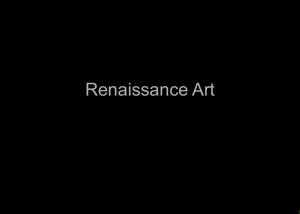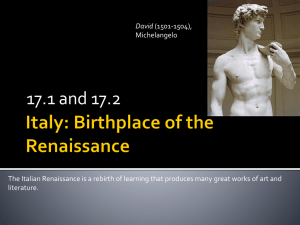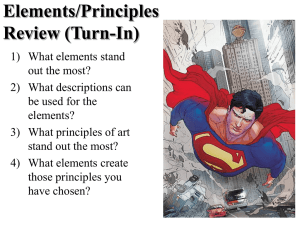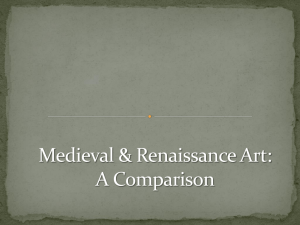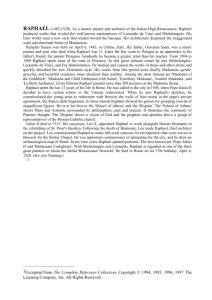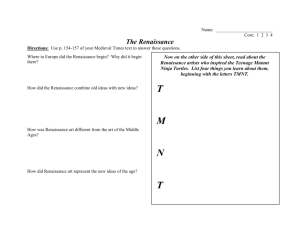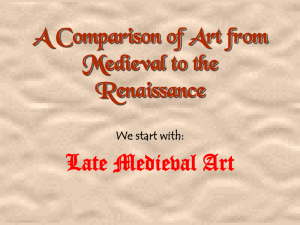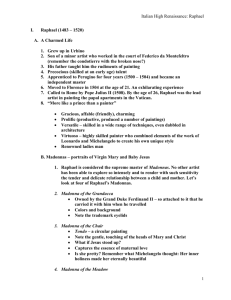Leonardo da Vinci
advertisement
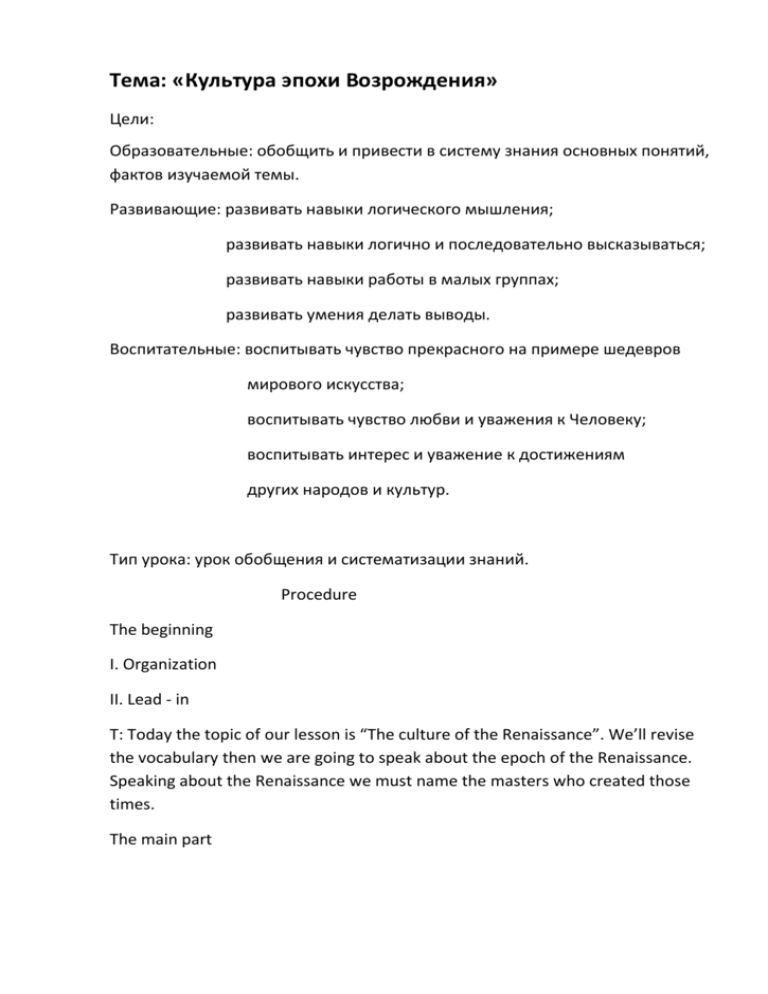
Тема: «Культура эпохи Возрождения» Цели: Образовательные: обобщить и привести в систему знания основных понятий, фактов изучаемой темы. Развивающие: развивать навыки логического мышления; развивать навыки логично и последовательно высказываться; развивать навыки работы в малых группах; развивать умения делать выводы. Воспитательные: воспитывать чувство прекрасного на примере шедевров мирового искусства; воспитывать чувство любви и уважения к Человеку; воспитывать интерес и уважение к достижениям других народов и культур. Тип урока: урок обобщения и систематизации знаний. Procedure The beginning I. Organization II. Lead - in T: Today the topic of our lesson is “The culture of the Renaissance”. We’ll revise the vocabulary then we are going to speak about the epoch of the Renaissance. Speaking about the Renaissance we must name the masters who created those times. The main part III. Vocabulary presentation T: Let’s revise the words which can help us speak about the epoch of the Renaissance. welfare - благо infinite in faculty – безграничные способности to ridicule shortcomings – высмеивать недостатки to interfere - вмешиваться to embody - воплощать the cognition of the world – познание мира to outlast - пережить inevitable - неизбежный available - доступный IV. The epoch of the Renaissance T: It is well known that in history the 15th and 16th centuries are called The period of Great Geographical Discoveries. You know that in 1492 Columbus discovered America, Vasco do Gamma found the way to India, Maggelan travelled around the world. What two epochs went side by side? P: The epoch of the Renaissance and the epoch of the Age of Exploration. T: The result of such co- existence became a man of Modern period. What was the Motherland of the Renaissance? P: It was Italy. T: Why did antique culture attract people of the XIV century? P: Antique culture glorified a man, his beautiful appearance and rich inner world. T: Who were humanists? P: Real admires of Antique culture were humanists. T: What was the greatest value for humanists? P: A man and his wefare. T: Were the humanists against religion? P: No, they criticized the shortcomings of Catholic Church. The humanists considered the God to be a creator of the world who didn’t interfere in people’s affairs. T: Why did a new ideal of a man appear in Italy? P: In Italy new cities grew very fast, crafts and trade developed. T: Schools and universities were opened. What kind of professions were in the new cities? P: Lawyers, accountants, engineers, teachers and doctors. T: Merchants, businessmen, bankers played the main role in the city life. The valued time and wanted to enjoy the life on the Earth, not afterlife. Humanists thought that each man, in spite of his origin, had a right to develop his abilities and admire nature, love, art, science. William Shakespeare said: “ What a piece of work is a man! The crown of creation!” V. William Shakespeare (Student’s report). VI. Group work (within 3 minutes to write down Shakespear’s famous plays). VI. The Titans of the Renaissance T: There was the trinity of great mastersof the Renaissance: Raphael was the embodiment of harmony, Leonardo of intellect, Michelangelo Buonarroty was the symbol of power and strength. VIII. Leonardo do Vinci The most universal of these Titans was Leonardo da Vinci (1452-1519) – an artist, sculptor, architect, the theorist of art, musician, poet, scientist and engineer. He created a project of flying machines, a submarine, a parachute, a machine gun, a swing bridge, etc. Leonardo’s inventions and theories greatly raced against time. The master thought that science must be based on experience which is the only source of knowledge. For Leonardo science and art were indivisible ways of the cognition of the world. In art he was a scientist, in science he was an artist. Leonardo was born in a town Vinci near Florence, which was a cultural centre of Italy. In Florence he became an artist. The Last Supper is considered to be his greatest painting. It was a huge fresco on the wall of the refectory of the Convent of Santa Maria della Grazie in Milan. The painting represents the last meal shared by Jesus with his disciples before his capture and death. Leonardo shows specifically the moment when Jesus has just said "One of you will betray me". Leonardo tells the story of the consternation that this statement caused to the twelve followers of Jesus and describes different people with different characters. In the portrait of a young woman known as the Mona Lisa or "la Gioconda" Leonardo achieved the top of portrait art. A slight smile of Mona Lisa, her sight, her inspired face shows the woman’s inner world, a sense of spiritual harmony. Leonardo da Vinci had a proud temper, changed patrons very often. He travelled all his life and died in France. IX. Raphael Raffaello Sanzio da Urbino or Raphael (14831520) is called the bright genius of the Renaissance. He was thirty years younger than Leonardo but outlasted him only one year. Despite his short life Raphael created a great number of masterpieces. His paintings were bright and harmonious. Raphael is called the Master of the Madonnas. Neither before nor after anybody managed to create so many perfect and at the same time different pictures of the Virgin and Child (the Madonna and Child). In his paintings The Virgin is sometimes young and tender, sometimes - in the image of an ordinary and tired peasant woman. The Madonna either keeps the Child Jesus in her arms, or plays with him in the background scenery. Sistine /ˈsɪsti:n/, Madonna, also called La Madonna di San Sisto is the top of Raphael’s creativity. It was painted for the Monastery of San Sisto in Piacenza. The Madonna, holding the Christ Child stands on clouds. She carries her son to people. In her face we see the prediction of her son’s inevitable death and at the same time the willingness to give it a sacrifice for the sake of humanity. The Christ Child’s sight is serious. He seems to know what awaits him in future. Sistine Madonna’s image impersonates people’s anxieties and sorrows, embodies bodily and spiritual beauty. Raphael was also a master of a monumental painting. On behalf of the Pope, he decorated three rooms in the Apostolic Palace in the Vatican. One of these frescoes got the name The School of Athens. Plato and Aristotle are in the centre. Around them, groups and individually, there are other antique philosophers. Raphael gave some of the characters features of his famous contemporaries: huge Plato is Leonardo, deeply thoughtful Heraclitus – Michelangelo, and one of Raphael lived only 37 years but managed to complete all his plans. Contemporaries and descendants called him Divine. His name became a synonym of an ideal artist who had a divine gift. After his sudden death he was buried in the Pantheon in Rome with high honors. On the tomb there was an inscription “Here lies that famous Raphael by whom Nature feared to be conquered while he lived, and when he was dying, feared herself to die”.his pupils is Raphael himself. The main idea of the fresco is the unity of different philosophical schools in the search for truth and the union of man with his unlimited cognitive abilities and the world. Raphael lived only 37 years but managed to complete all his plans. Contemporaries and descendants called him Divine. His name became a synonym of an ideal artist who had a divine gift. After his sudden death he was buried in the Pantheon in Rome with high honors. On the tomb there was an inscription “Here lies that famous Raphael by whom Nature feared to be conquered while he lived, and when he was dying, feared herself to die”. X. Michelangelo In the trinity of great masters of the Renaissance Raphael was the embodiment of harmony, Leonardo of intellect, Michelangelo Buonarroti (1475-1564) was the symbol of power and strength. He was a sculptor, an architect, an engineer, a poet and was considered to be the greatest living artist in his lifetime. He lived for about 89 years, a whole epoch. During this period thirteen Popes changed. Michelangelo worked for nine of them. He was also the first European artist whose lifetime biography was printed by his contemporaries. First of all, Michelangelo was a sculptor. One of the most famous his sculptures is the Statue of David, which embodied a humanistic ideal of a heroic, powerful and proud man. The statue represents the Biblical hero David before his battle with Goliath. He carries his sling casually thrown over his left shoulder. He has a stone in his left hand. The right side of his body is in tension while the left one is relaxed. The image of David had a special sense for Florentines so the sculpture attracted everyone's attention. A five-meter statue was placed in a public square in Florence and became the symbol of independent republic. The first Michelangelo’s biographer wrote that the Statue of David became more glorious than all contemporary and antique statues, Greek and Roman ever made. Under the patronage /ˈpætrənɪdʒ/ of the Pope, Michelangelo painted the Sistine Chapel in the Apostolic Palace for 26 months in difficult conditions. Within 4 years over an area of 600 square meters in 300 figures the master represented the history of mankind from the first days of Creation to the Flood. It was a real feat of the artist. The Frescoes of the Sistine Chapel is believed the greatest achievement of man in the history of painting. XI. Fill in the table Masters of the Renaissance Origin Masterpieces Leonardo do Vinci Italy The Last Supper, the Mona Lisa Raphael Italy Sistine Madonna Michelangelo Italy The Statue of David William Shakespeare England Hamlet, Romeo & Juliet The ending XII. Conclucion T: What was the main theme of the Renaissance? P: A beautiful, harmoniously developed man with unlimited creative abilities. XIII. Evaluation XIV. H.W.
